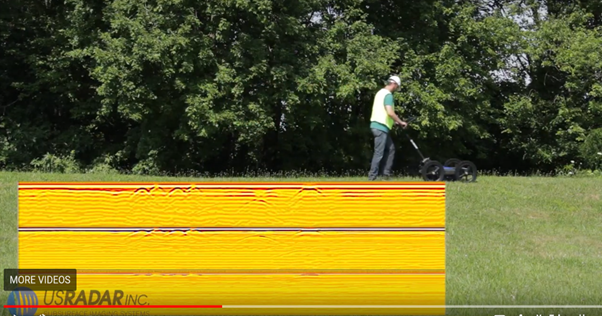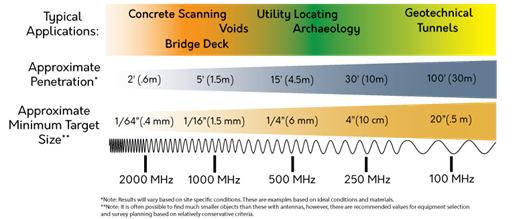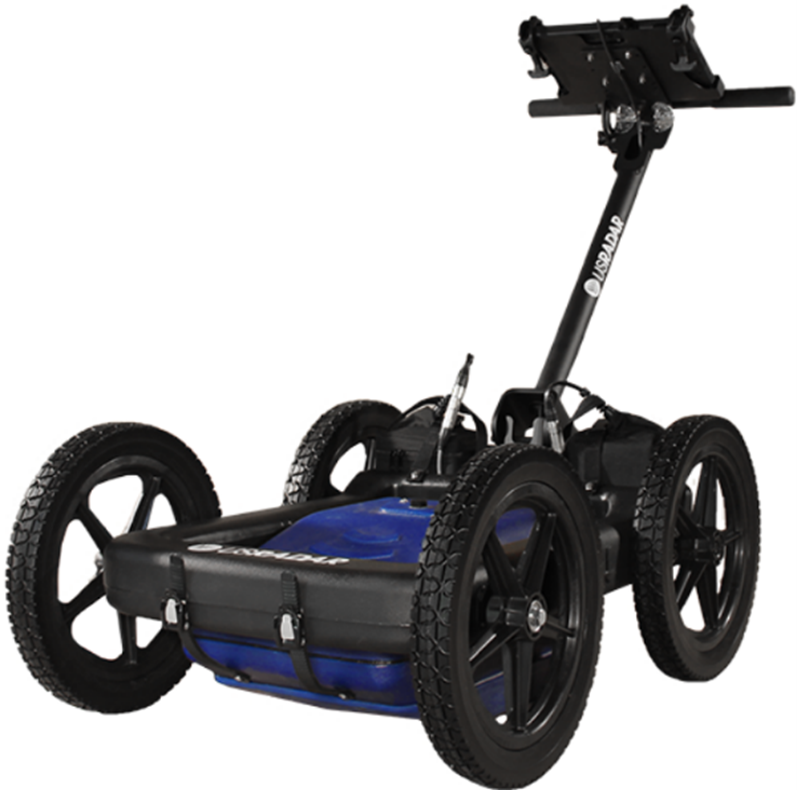Quantum Imager Triple Frequency GPR System
We at Caritas Infra Consulting Pvt. Ltd., New Delhi strongly believe in quality services and work outputs. During the procurement of GPR we did a lot of market research and found the best compacted GPR with US Radar, New Jersey, USA - the “Triple Frequency GPR System” was directly imported from USA to provide a quality work outputs. Due to the multiple RFs the object clarity at shallow depth is very high with the use of higher frequency whereas due to the presence of lower frequency sensor the penetration is high to detect easily any object at greater depth as well.
The ensuing paragraphs will provide a fare insight about the GPR and its functionalities.
Overview
The Quantum Imager is the first true triple frequency range GPR system ever produced. Because the antenna emits three separate signals simultaneously, the user can survey significantly greater depths with higher resolution than any other locating technology without sacrificing middle frequencies which are ideal for locating targets like buried utilities. Stepped ultra wideband pulses combine the advantages of pulse radar and stepped frequency radar for unsurpassed resolution and depth. New direct RF sampling technology creates clearer, easier to understand images than previously possible with older radar technologies. All these components work together to make locating easier while providing superior results.
Applications
With greater depth and resolution than any other locating technology, the Quantum Imager can be used for anything from fibre optic analysis to utilities up to 30′(9m)+ deep and everything in between.
How Does GPR Work?
Every GPR system contains one or more antennas that transmit and receive radio frequency waves. These radio waves penetrate the surface that the antenna is touching or in close proximity to. While much of the signal dissipates, a percentage of the signal comes back to be received by the antenna. This return signal generates visual data that can be recorded, interpreted and manipulated. The data is displayed on a control unit as images that give the operator the ability to see the size of objects and the depths at which they are located.
GPR has the same basic principles as a metal detector. A metal detector sends energy into the earth in up to 17 frequencies. When that energy meets a metallic object, it is translated into a recognizable tone. Similarly, GPR sends out millions of frequencies that return to the antenna and provide visual data of the subsurface and objects buried within.
Radar is sensitive to changes in material composition. Detecting these changes requires movement. In the case of air traffic control radar, the targets are moving, so a stationary transmitter works. GPR systems, however, are designed to locate stationary targets, so one must move the radar to detect them.

What can GPR find?
U S Radar Systems are engineered to display differences in material composition. They can be used for locating objects with different compositions than their surrounding materials. A PVC pipe, for example, has a different composition than the surrounding soil. Similarly, voids and excavations that have been filled in will also have different compositions than the surrounding soil.
One should note, however, that GPR cannot determine the actual materials that the system is imaging. For this reason, it is not suited for locating gold, precious gems, or other treasure.
Here are some objects that GPR can help you find.
Utlity Service: Clay Pipes, Plastic/PVC, Concrete Pipe, Transit Pipe, Metal Pipe, missing Valves, Water Boxes, Abandoned Lines, Illegal/Unknown Connection, Conduit, Water/Wastewater, Gas, Power, CATV, Telecom Wire, Fibre Optic, Septic Tanks, Voids, Manholes, and More
Structural Analysis: Reinforcing, Cracking, Voids, Concrete Sparling, Slab/Wall Thickness, Asphalt Layer Thickness, and More
Geotechnical: Density Changes, Fill Placement, Boulders/Rocks, Root Mass, Disturbed Soil, Buried Wood, and More
Law Enforcement: Weapons, Drugs, Cadavers, Cash, and More
Environmental: Contaminant Plumes/Migrations, Landfill Limits, Buried Drums, and More
Humanitarian: UXO, Graves, and More
The 500 MHz antenna is the antenna which is most widely used for locating utilities.
The 1000 MHz antenna is the most widely used for locating rebar and utilities in walls and floors.
One should not that, if it is not possible to reach the depth of a buried utility due to soil conditions, it is still often possible to detect the disturbed soil from the original excavation.
GPR Selection Guidelines
Selecting the right GPR system for your specific needs depends on the application you are using for; such as construction, utility locating, archaeology, etc. The application often determines the required depth of penetration and resolution capabilities. Users who need data from different depth ranges, want more comprehensive data, and have broader needs require multi-frequency systems.
Here is a chart of where our products fit within particular depth ranges, applications, and other factors one may consider in purchasing ground penetrating radar:


